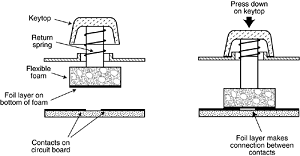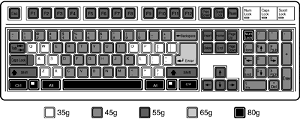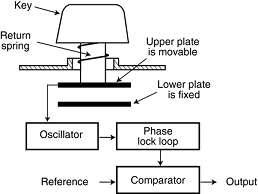Keyboard Keyswitch Design
Today's keyboards use any one of several switch types to create the action for each key. Most keyboards use a variation of the mechanical keyswitch. A mechanical keyswitch relies on a mechanical momentary contact-type switch to make the electrical contact that forms a circuit.
Some high-end keyboards use a more sophisticated design that relies on capacitive switches. This section discusses these switches and the highlights of each design. The most common type of keyswitch is the mechanical type, available in the following variations:
-
Pure mechanical
-
Foam element
-
Rubber dome
-
Membrane
Pure Mechanical Switches
The pure mechanical type is just that—a simple mechanical switch that features metal contacts in a momentary contact arrangement. The switch often includes a tactile feedback mechanism, consisting of a clip and spring arrangement designed to give a "clicky" feel to the keyboard and offer some resistance to the keypress

Mechanical switches are very durable, usually have self-cleaning contacts, and are normally rated for 20 million keystrokes (which is second only to the capacitive switch in longevity). They also offer excellent tactile feedback.
Despite the tactile feedback and durability provided by mechanical keyswitch keyboards, they have become much less popular than membrane keyboards (discussed later in this chapter).
In addition, many companies that produce keyboards that use mechanical keyswitches either use them for only a few of their high-priced models or have phased out their mechanical keyswitch models entirely.
With the price of keyboards nosediving along with other traditional devices, such as mice and drives, the pressure on keyboard makers to cut costs has led many of them to abandon or de-emphasize mechanical-keyswitch designs in favor of the less expensive membrane keyswitch.
The Alps Electric mechanical keyswitch is used by many of the vendors who produce mechanical-switch keyboards, including Alps Electric itself. Other vendors who use mechanical keyswitches for some of their keyboard models include Adesso, Inc., Avant Prime and Stellar, Kinesis, SIIG, and Focus. Many of these vendors sell through the OEM market, so you must look carefully at the detailed specifications for the keyboard to see whether it is a mechanical keyswitch model.
Foam Element Switches
Foam element mechanical switches were a very popular design in some older keyboards. Most of the older PC keyboards, including models made by Key Tronic and many others, used this technology. These switches are characterized by a foam element with an electrical contact on the bottom. This foam element is mounted on the bottom of a plunger that is attached to the key.

When the switch is pressed, a foil conductor on the bottom of the foam element closes a circuit on the printed circuit board below. A return spring pushes the key back up when the pressure is released.
The foam dampens the contact, helping to prevent bounce, but unfortunately it gives these keyboards a "mushy" feel. The big problem with this type of keyswitch design is that little tactile feedback often exists.
These types of keyboards send a clicking sound to the system speaker to signify that contact has been made. Preferences in keyboard feel are somewhat subjective; I personally do not favor the foam element switch design.
Another problem with this type of design is that it is more subject to corrosion on the foil conductor and the circuit board traces below. When this happens, the key strikes can become intermittent, which can be frustrating. Fortunately, these keyboards are among the easiest to clean.
By disassembling the keyboard completely, you usually can remove the circuit board portion—without removing each foam pad separately—and expose the bottoms of all the pads. Then, you easily can wipe the corrosion and dirt off the bottoms of the foam pads and the circuit board, thus restoring the keyboard to a "like-new" condition.
Unfortunately, over time, the corrosion problem will occur again. I recommend using some Stabilant 22a from D.W. Electrochemicals to improve the switch contact action and prevent future corrosion. Because of such problems, the foam element design is not used much anymore and has been superseded in popularity by the rubber dome design.
KeyTronicEMS, the most well-known user of this technology, now uses a center-bearing membrane switch technology in its keyboards, so you are likely to encounter foam-switch keyboards only on very old systems.
Rubber Dome Switches
Rubber dome switches are mechanical switches similar to the foam element type but are improved in many ways. Instead of a spring, these switches use a rubber dome that has a carbon button contact on the underside. As you press a key, the key plunger presses on the rubber dome, causing it to resist and then collapse all at once, much like the top of an oil can.
As the rubber dome collapses, the user feels the tactile feedback, and the carbon button makes contact between the circuit board traces below. When the key is released, the rubber dome re-forms and pushes the key back up. The rubber eliminates the need for a spring and provides a reasonable amount of tactile feedback without any special clips or other parts.
Rubber dome switches use a carbon button because it resists corrosion and has a self-cleaning action on the metal contacts below. The rubber domes themselves are formed into a sheet that completely protects the contacts below from dirt, dust, and even minor spills.
This type of switch design is the simplest, and it uses the fewest parts. This made the rubber dome keyswitch very reliable for several years. However, its relatively poor tactile feedback has led most keyboard manufacturers to switch to the membrane switch design covered in the next section.
Membrane Switches
The membrane keyswitch is a variation on the rubber dome type, using a flat, flexible circuit board to receive input and transmit it to the keyboard microcontroller. Industrial versions of membrane boards use a single sheet for keys that sits on the rubber dome sheet for protection against harsh environments.
This arrangement severely limits key travel. For this reason, flat-surface membrane keyboards are not considered usable for normal touch typing. However, they are ideal for use in extremely harsh environments. Because the sheets can be bonded together and sealed from the elements, membrane keyboards can be used in situations in which no other type could survive.
Many industrial applications use membrane keyboards for terminals that do not require extensive data entry but are used instead to operate equipment, such as cash registers and point-of-sale terminals in restaurants. Membrane keyswitches are no longer relegated to fast food or industrial uses, though.
Over the last few years, the membrane keyswitch used with conventional keyboard keytops has replaced the rubber dome keyswitch to become the most popular keyswitch used in low-cost to mid-range keyboards. Inexpensive to make, membrane switches have become the overwhelming favorite of low-cost Pacific Rim OEM suppliers and are found in most of the keyboards you'll see at your local computer store, or find inside the box of your next complete PC.
Although low-end membrane keyswitches have a limited life of only 5–10 million keystrokes, some of the better models are rated to handle up to 20 million keystrokes, putting them in the range of pure mechanical switches for durability.

A few membrane switches are even more durable: Cherry Corporation's G8x-series keyboards use Cherry's own 50-million-keystroke membrane switch design.
Membrane keyboards provide a firmer touch than rubber dome keyboards or the old foam-element keyboards, but they are still no match for mechanical or capacitive keyswitch models in their feel.
One interesting exception is the line of keyboards made by KeyTronicEMS using its center-bearing version of membrane keyswitches.
Most of its keyboards feature Ergo Technology, which has five levels of force from 35 grams to 80 grams, depending on the relative strength of the fingers used to type various keys.
As little as 35 grams of force is required for keys that are used by the little finger, such as Q, Z, and A, and greater levels of force are required for keys used by the other fingers. The spacebar requires the most force: 80 grams.

This compares to the standard force level of 55 grams for all keys on normal keyboards. To find the best membrane keyboards from the vast numbers on the market, look at the lifespan rating of the keyswitches. Longer-lasting keyswitches make the keyboard cost more but will lead to a better experience over the life of the keyboard.
Capacitive Switches
Capacitive switches are the only nonmechanical keyswitch in use today. The capacitive switch is the Cadillac of keyswitches. It is much more expensive than the more common mechanical membrane switch, but it is more resistant to dirt and corrosion and offers the highest-quality tactile feedback of any type of switch.

This type of keyboard is sometimes referred to as a buckling spring keyboard because of the coiled spring used to provide feedback. A capacitive switch does not work by making contact between conductors.
Instead, two plates usually made of plastic are connected in a switch matrix designed to detect changes in the capacitance of the circuit.
When the key is pressed, the plunger moves the top plate in relation to the fixed bottom plate. Typically, a buckling spring mechanism provides for a distinct over-center tactile feedback with a resounding "click." As the top plate moves, the capacitance between the two plates changes. The comparator circuitry in the keyboard detects this change.
Because this type of switch does not rely on metal contacts, it is nearly immune to corrosion and dirt. These switches are also very resistant to the key bounce problems that result in multiple characters appearing from a single strike. In addition, they are the most durable in the industry—rated for 25 million or more keystrokes, as opposed to 10–20 million for other designs.
The tactile feedback is unsurpassed because the switch provides a relatively loud click and a strong over-center feel. The only drawback to the design is the cost. Capacitive switch keyboards are among the most expensive designs. The quality of the feel and their durability make them worth the price, however. Originally, the only vendor of capacitive keyswitch keyboards was IBM.
Although some of IBM's older keyboards still feature capacitive keyswitches, most current IBM keyboards use rubber-dome or other lower-cost keyswitches. In 1991, IBM spun off its keyboard/printer division as Lexmark, which then spun off the keyboard division as Unicomp in 1996.
Today, Unicomp still manufactures and sells "IBM" keyboards with the classic buckling spring capacitive switch ("clickety" as some would say) technology. As a bonus, it also has models with the IBM trackpoint built in.